You can eliminate yard fleas fast using beneficial nematodes, which kill flea larvae and adults within 24-48 hours by releasing fatal bacteria inside their bodies. Apply diatomaceous earth in thin layers across dry soil for immediate contact killing, or use cedar wood chips that release natural repelling oils. Essential oil sprays with rosemary, lavender, or peppermint also provide quick deterrent effects when applied to flea-infested areas. These methods work even faster when you understand proper application techniques.
Understanding Fleas and Their Life Cycle
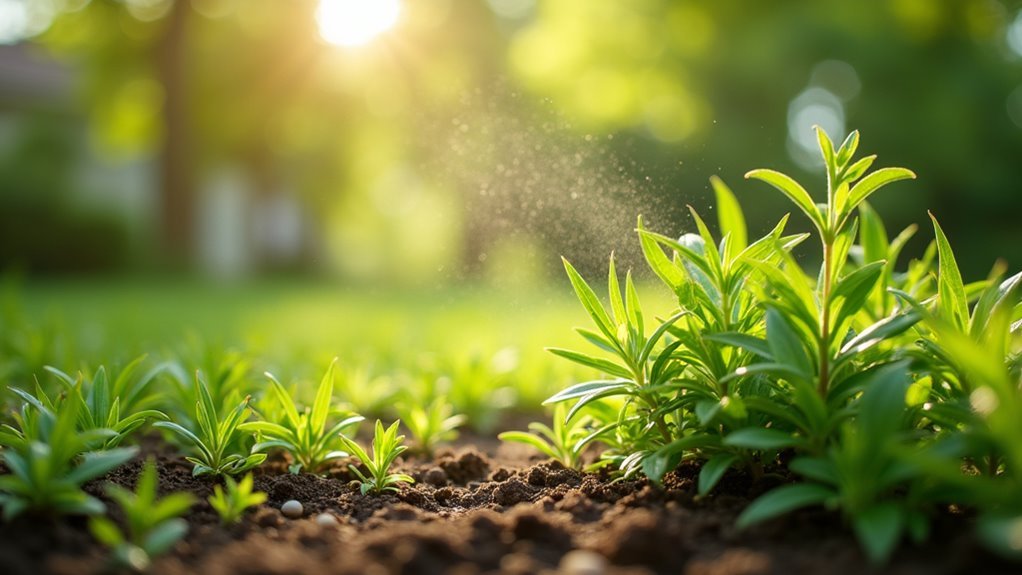
Before you can effectively eliminate fleas from your yard, you’ll need to understand these persistent parasites and how they operate.
Fleas are blood-feeding parasites that target warm-blooded animals, including your pets and family. A single female can produce up to 2,000 flea eggs during her lifetime, rapidly expanding the flea population in your outdoor space.
The flea life cycle includes four distinct stages: egg, larva, pupa, and adult. Environmental factors like temperature and humidity directly affect how quickly flea larvae develop into biting adults.
Adult fleas can survive months without hosts, making flea infestations particularly challenging to control.
You’ll recognize flea infestations through telltale signs like “flea dirt” (black specks), excessive pet scratching, and visible fleas on light-colored surfaces throughout your yard.
Identifying Flea Infestations in Your Yard
Before you can tackle a flea problem with organic methods, you’ll need to confirm these pests have actually invaded your yard.
You can spot flea infestations by looking for telltale visual signs like reddish-brown “flea dirt” in areas your pets frequent, watching for changes in your pet’s behavior such as excessive scratching or biting at their skin, and evaluating your yard’s conditions for flea-friendly environments.
These identification steps will help you determine the severity of your infestation and target your organic treatment efforts effectively.
Visual Flea Detection Signs
The telltale signs of a flea infestation in your yard aren’t always immediately obvious, but you can spot them if you know what to look for.
Start by searching for flea dirt—brown or reddish specks of flea feces made from digested blood on grass and surfaces. You’ll notice your pets scratching excessively or developing hair loss patterns.
Try the white socks test: walk through your yard wearing white socks to easily spot fleas against the bright fabric.
Watch for itchy bites on yourself and family members after spending time outdoors.
Focus your inspection on shaded areas under bushes, patio furniture, and tall grass where fleas prefer to hide and reproduce.
Pet Behavior Changes
When fleas invade your yard, your pets become living indicators of the problem through dramatic behavioral shifts.
You’ll notice increased scratching, biting, and excessive grooming that creates patches of hair loss and skin irritation. These pet behavior changes signal fleas in your yard have found new hosts.
Watch for restlessness or your pet’s sudden reluctance to go outside – clear signs of flea infestation in outdoor spaces.
If your dog stops rolling in grass or frequently shakes their body during yard time, fleas are likely present. Your cat might avoid lounging on outdoor furniture they previously enjoyed.
These behavioral indicators help you identify problems early, allowing you to implement natural flea control methods quickly.
Recognizing these signs enables prompt treatment with natural remedies before infestations worsen.
Yard Condition Assessment
Conducting a thorough yard condition assessment reveals critical information about flea populations before they become overwhelming problems. When you assess your yard, focus on moist, shaded areas where fleas thrive. Look for brown or reddish “flea dirt” around pet resting spots and in grass areas. Walking through tall grass wearing white socks helps detect fleas that’ll cling to the fabric. Regular inspections of entry points where wild animals access your property prevent external flea introductions.
| Assessment Area | Signs of a Flea Infestation |
|---|---|
| Shaded/Moist Zones | Brown flea dirt, excessive pet scratching |
| Pet Rest Areas | Hair loss, reddish debris |
| Tall Grass | Fleas on white socks |
| Animal Entry Points | Wildlife tracks, droppings |
| General Yard | Pet behavioral changes |
This systematic approach identifies your flea problem early, enabling effective natural treatments.
Beneficial Nematodes for Rapid Flea Elimination
Although chemical pesticides dominate many flea control strategies, beneficial nematodes offer a powerful organic alternative that can eliminate flea populations within just 24 to 48 hours of application.
Beneficial nematodes provide a fast-acting organic solution that eliminates fleas naturally within 24-48 hours without harmful chemicals.
These microscopic worms actively kill fleas during both larval and adult stages by entering their bodies and releasing fatal bacteria. This biological control method delivers impressive flea population reduction while remaining completely safe for your family and pets.
You’ll achieve superior results by keeping treated areas consistently moist, as nematodes thrive in damp soil conditions.
They’re particularly effective at interrupting their lifecycle, preventing flea larvae from reaching maturity and breaking the infestation cycle.
Apply nematodes during cooler parts of the day and water thoroughly afterward to maximize their survival and effectiveness in your yard.
Diatomaceous Earth Application Methods
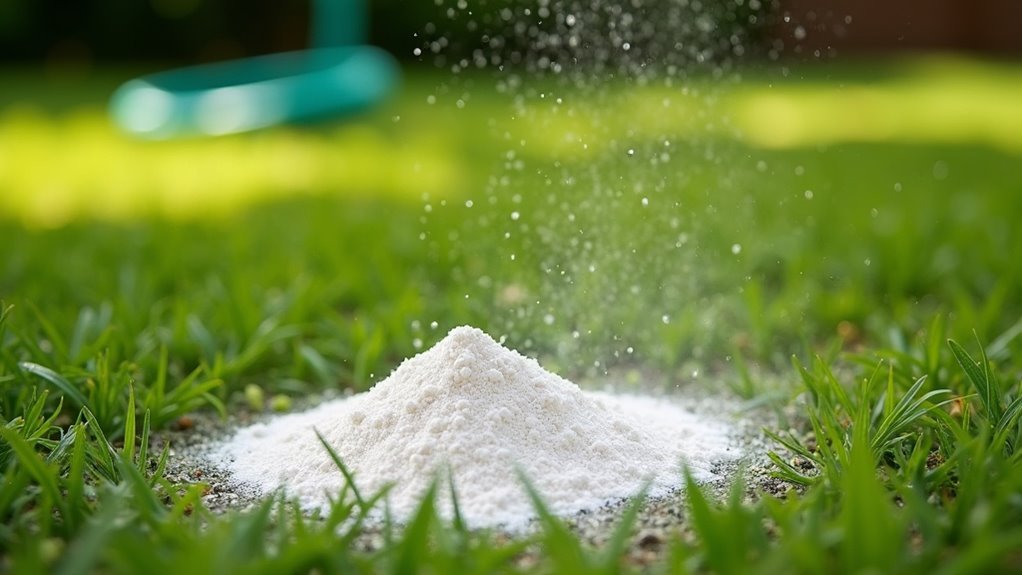
Diatomaceous earth provides another highly effective organic weapon against yard fleas through its unique physical action that dehydrates these pests on contact.
You’ll need to apply DE in a thin, even layer across dry soil and vegetation where fleas congregate. Focus on shaded areas under bushes, porches, and pet resting spots.
Always wear protective gear including goggles, face masks, and long sleeves to prevent particle irritation. Timing matters considerably – apply when no rain’s expected for 24-48 hours since moisture reduces effectiveness.
The fine particles work by cutting through flea exoskeletons, causing fatal dehydration. You’ll need to reapply DE after heavy rainfall or morning dew to maintain consistent flea control throughout your yard.
Cedar Wood Chips as Natural Flea Deterrents
You’ll find cedar wood chips offer a natural, aromatic solution for repelling fleas in your yard without harsh chemicals.
These chips work by releasing natural oils that create an unwelcome environment for fleas, ticks, and mosquitoes while remaining completely safe for your family and pets.
When applied correctly and refreshed regularly, cedar chips can markedly reduce flea populations as part of your integrated pest management approach.
Cedar Chip Application Methods
Cedar wood chips offer a fragrant, pet-safe solution for creating natural barriers against fleas in your outdoor spaces.
These effective application methods will help you maximize their potential as a natural deterrent. Spread cedar wood chips generously under porches, around shrubs, and in shaded areas where your pets frequently rest.
Focus on zones with limited sunlight, as fleas thrive in these conditions. Apply a thick layer to create extensive coverage that’ll repel fleas through released natural oils.
You’ll need to refresh the chips every 4 to 6 weeks to maintain effectiveness. Strategic placement helps promote airflow while disrupting flea habitats.
For enhanced results, combine cedar wood chips with other organic methods like beneficial nematodes to create multiple defense layers against these persistent pests.
Effectiveness Against Fleas
While proper application sets the foundation for success, understanding how cedar wood chips actually combat fleas will help you gauge their true potential in your yard.
Cedar chips work as an effective deterrent through their natural oil compounds that repel fleas, ticks, and mosquitoes on contact.
Here’s how cedar chips deliver reliable flea control:
- Natural barrier protection – Creates a perimeter defense that discourages flea infestation while maintaining pleasant aromatics
- Enhanced combination power – Works synergistically with natural flea predators like beneficial nematodes for amplified results
- Family-friendly solution – Safe to use around pets, children, and plants unlike harsh chemical alternatives
Among organic methods, cedar chips offer consistent performance when you reapply them every 4-6 weeks, especially in high-moisture areas where pets frequently roam.
Proper Lawn Maintenance for Flea Prevention
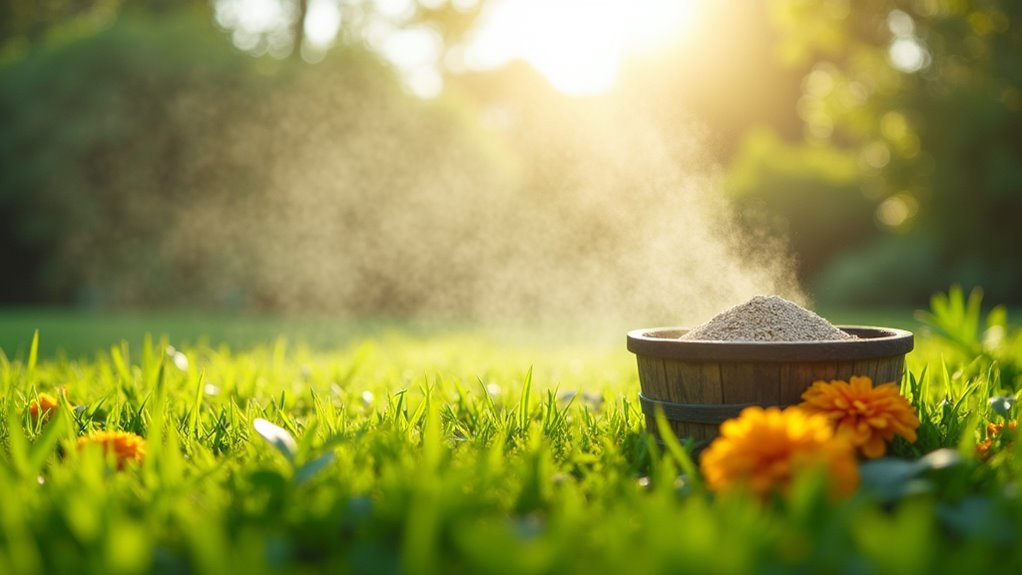
Since fleas thrive in overgrown, shaded environments, maintaining a well-groomed lawn becomes your first line of defense against these persistent pests. Regular lawn mowing prevents tall grass that creates a shaded habitat where fleas and larvae flourish.
You’ll want to rake and remove organic debris like leaves and twigs, which harbor flea eggs and support their development. Proper drainage is essential—eliminate standing water that creates moist breeding conditions fleas love.
Trim shrubs and vegetation around your home to increase sunlight exposure and improve airflow, making your yard less appealing to flea populations. Pay special attention to areas where your pets spend time, cleaning these spaces regularly to minimize flea habitats and maintain overall yard health.
Essential Oil-Based Yard Treatments
You’ll find that selecting the right essential oils can make a significant difference in your flea control efforts.
Rosemary, lavender, peppermint, and cedarwood oils stand out as the most effective options for repelling fleas naturally.
To maximize their impact, you’ll need to understand proper dilution ratios and application techniques that guarantee thorough coverage of flea-infested areas.
Effective Oil Selection
Although chemical pesticides dominate the market, essential oils offer a powerful organic alternative that can effectively eliminate yard fleas when you select the right combinations.
For Natural Flea Treatments, you’ll want to focus on specific oils that disrupt flea life cycles and repel adult insects effectively.
The most effective essential oils for yard flea control include:
- Rosemary oil – Creates a 1% concentration spray when mixed with water and soap
- Cedarwood oil – Disrupts flea development and acts as a natural deterrent
- Citrus oils – Fresh lemon extracts repel fleas through scent and taste aversion
You can enhance these treatments by combining essential oils with diatomaceous earth for maximum impact.
Always dilute oils properly and reapply every few days during peak flea season.
Proper Application Methods
When applying essential oil treatments to your yard, proper technique determines whether you’ll achieve effective flea control or waste time with subpar results.
These natural remedies require strategic application methods for maximum effectiveness. Use a garden sprayer to distribute your 1% essential oils mixture evenly across infested areas, concentrating on shady spots where fleas congregate.
Always perform a patch test on a small grass section before widespread application to prevent plant damage.
Apply treatments during dry weather conditions and reapply every few days, particularly after rainfall.
You can also create homemade flea powders by combining essential oils with baking soda for moisture absorption.
Focus your efforts on areas where pets spend time, ensuring thorough coverage of potential flea hiding spots throughout your yard.
Homemade Vinegar and Citrus Sprays
Two simple household ingredients can transform your flea control strategy without exposing your family or pets to harsh chemicals.
Homemade vinegar and citrus sprays serve as powerful natural deterrents that target flea-infested areas effectively.
Create your homemade vinegar solution by mixing equal parts distilled white vinegar or apple cider vinegar with water.
For citrus sprays, combine 1/4 cup fresh lemon juice with 2 cups water.
These cost-effective alternatives work because fleas dislike their scents and tastes.
- Apply vinegar spray directly to infested areas where fleas congregate
- Use citrus solutions on bedding and areas around young animals safely
- Reapply regularly to maintain a flea-free yard and prevent future infestations
Both solutions offer safe, budget-friendly pest control that protects your family while eliminating fleas naturally.
Salt and Baking Soda Ground Applications
Your pantry holds two powerful weapons against yard fleas that cost pennies compared to commercial pesticides. Salt and baking soda work as natural desiccants, dehydrating both adult fleas and their eggs on contact.
These organic methods offer exceptional pet safety since they’re completely non-toxic around children and animals.
Sprinkle both substances generously across affected lawn areas, focusing on spots where your pets frequently rest or play. The combination enhances effectiveness as both ingredients attack flea moisture content simultaneously.
Let the treatment sit for at least 24 hours to guarantee maximum absorption.
After the waiting period, water the treated areas lightly to help the salt and baking soda penetrate deeper into the soil, creating an inhospitable environment for surviving fleas and preventing future infestations.
Commercial Natural Flea Products
While pantry staples provide budget-friendly solutions, commercial natural flea products offer ready-made convenience with scientifically formulated ingredients.
Wondercide and similar brands utilize plant-based components like cedarwood and sesame oil to effectively repel and eliminate fleas throughout their life cycles, making them safe for pets and home use.
These products typically feature:
- Garden hose attachments for easy yard application coverage
- Multi-stage effectiveness targeting eggs, larvae, and adult fleas
- Eco-friendly formulations that reduce chemical runoff
You’ll find these commercial natural flea products work best when combined with other flea-killing methods for thorough pest control.
While they may require multiple applications for severe infestations, their environmental focus promotes healthier ecosystems while managing flea populations effectively across your property.
Long-Term Prevention Strategies
Although eliminating existing fleas provides immediate relief, establishing consistent long-term prevention strategies guarantees your yard remains flea-free throughout the seasons.
You’ll need to maintain regular lawn care by mowing frequently and clearing debris to eliminate flea habitats while promoting sun exposure that deters survival.
Apply beneficial nematodes seasonally to continuously target larvae in soil, achieving up to 100% elimination rates.
Incorporate aromatic herbs like lavender and rosemary throughout your landscape, as their natural oils create ongoing repellent barriers.
Refresh cedar wood chips every 4-6 weeks around your yard’s perimeter for sustained protection.
Maintain a regular cleaning routine indoors, including vacuuming carpets and washing pet bedding in hot water to prevent reinfestation cycles.
Frequently Asked Questions
What Is the Fastest Way to Get Rid of Fleas in the Yard?
You’ll get fastest results by applying beneficial nematodes, which kill fleas within 24-48 hours, while simultaneously sprinkling diatomaceous earth in dry areas and maintaining regular lawn care to disrupt flea habitats.
What Is the Best Homemade Flea Killer for the Yard?
You’ll find the salt and baking soda mixture works best as a homemade flea killer. Mix one cup each, then sprinkle liberally where fleas are active—both ingredients dehydrate and kill fleas effectively.
What Eats Fleas in the Yard Naturally?
You’ll find beneficial nematodes, chickens, opossums, spiders, and certain beetles naturally consume fleas in your yard. Entomopathogenic fungi also kill fleas, while diverse plant life attracts these helpful predators to control populations.
What Do Farmers Use to Kill Fleas?
You’ll find farmers use beneficial nematodes to target flea larvae within 48 hours. They also apply diatomaceous earth for dehydration, cedar chips as repellents, and vinegar solutions while practicing integrated pest management techniques.
In Summary
You’ve learned multiple organic methods to eliminate yard fleas quickly and safely. Start with beneficial nematodes for immediate results, then apply diatomaceous earth in problem areas. Use cedar chips around your property’s perimeter and spray homemade vinegar solutions weekly. Don’t forget to treat indoor pets and vacuum regularly. Combining these natural approaches will create an inhospitable environment for fleas while keeping your family and pets safe from harmful chemicals.

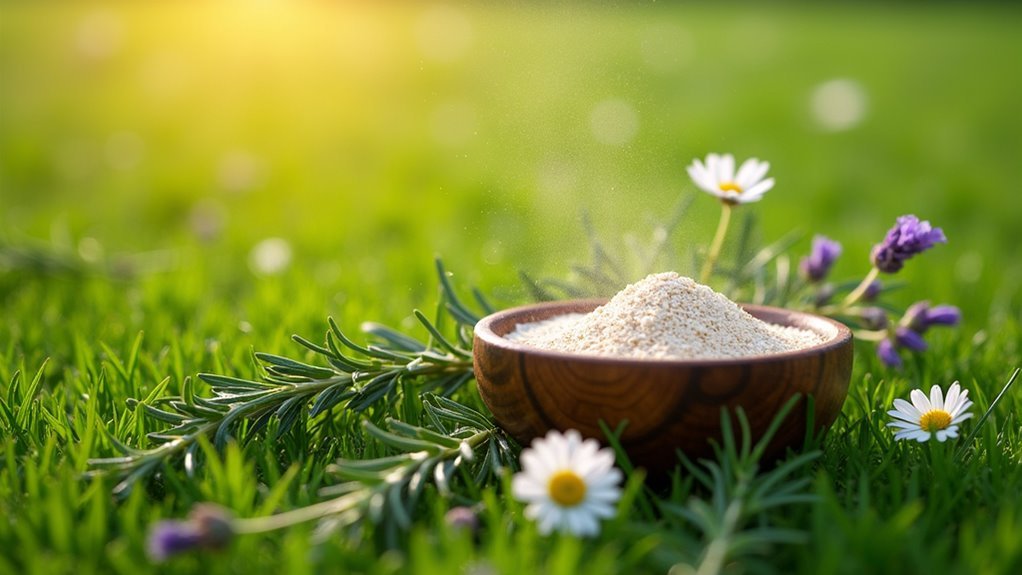

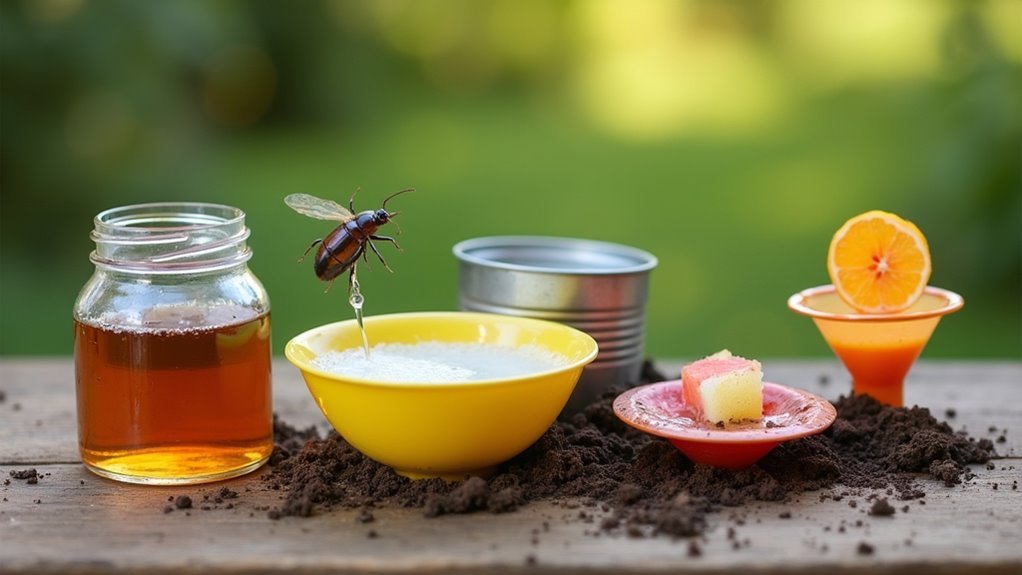

Leave a Reply